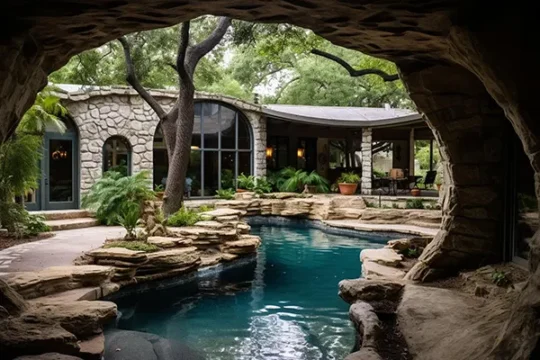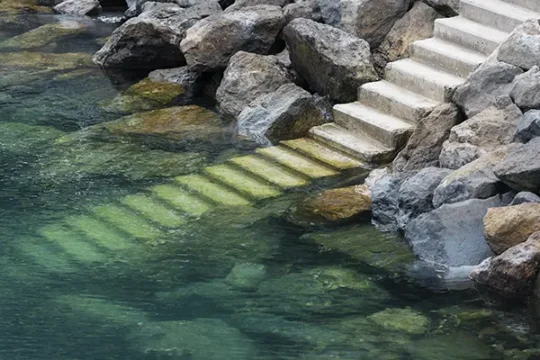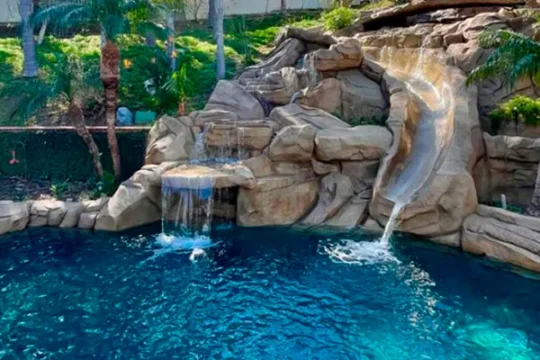TABLE OF CONTENTS
There’s nothing quite like walking out to your pool on a perfect morning, coffee in hand, ready to relax—only to find the water looking like someone poured milk in it. Yesterday everything was fine. Today? It looks like a pond.
This happens to rock pool owners all the time. One day the water’s sparkling, the next day it’s murky and gross. And when you start searching online for answers, most advice just says “balance your chemicals” without actually explaining what that means or why it matters.
Rock pools are beautiful—that’s the whole point of having one. But those gorgeous waterfalls, caves, and textured surfaces that make them look so amazing? They also trap debris and create challenges that regular rectangular pools just don’t have. More nooks and crannies means more places for problems to hide and grow.
The thing is, once you understand what’s actually causing the cloudiness, fixing it isn’t rocket science. You just need to know what you’re dealing with.
What’s Really Going On With Your Pool Water?
Cloudy water means there’s stuff floating around in there that shouldn’t be. Could be tiny particles, bacteria doing their thing, or chemicals that aren’t playing nice together. With rock pools, the challenge gets bigger because there’s just so much more surface area compared to a basic pool setup.
Think about a simple rectangular pool versus one with artificial rocks, a waterfall, maybe a slide, and all those cool textured surfaces. The rock pool has probably ten times more places where debris can get stuck or algae can start growing. Water doesn’t circulate as easily through all those crevices and corners. The skimmer can’t reach everywhere.
This isn’t meant to scare anyone off rock pools. They’re worth it. But understanding that they work a bit differently helps explain why cloudiness happens and what to do about it.
Your Filter Might Be Begging for Attention
Here’s something a lot of people don’t realize at first: filters need regular cleaning. It’s easy to assume they just keep working forever without any maintenance. Set it and forget it, right? Wrong.
Filters get clogged. Skimmer baskets fill up with leaves, bugs, random stuff that blows into the pool. When that happens, water just keeps circulating without actually getting cleaned. All those tiny particles making the water look cloudy? They’re still in there, still floating around, probably multiplying.
And if the pump’s only running a few hours a day because of electric bill concerns, that’s usually not enough time. Rock pools really need 8 to 10 hours minimum to keep everything circulating properly and give the filter enough time to do its job. Skimping on runtime to save a few bucks often leads to spending way more money fixing water quality problems later.
The Chemistry Puzzle Nobody Warns You About
Pool chemistry sounds complicated, but it boils down to a few things that really matter. pH, chlorine, and alkalinity all work together, and when one gets out of whack, the others start having problems too.
High pH is sneaky. When pH goes up—which happens a lot after it rains—chlorine basically stops working. Someone could dump in tons of chlorine and it won’t do anything because the pH is blocking it. That’s frustrating as hell when you’re adding chemicals and not seeing any improvement.
Not enough chlorine lets bacteria party in the pool. That’s what creates that cloudy, uninviting look. And when alkalinity goes wonky, white cloudy deposits show up all over the rocks. Looks terrible and takes forever to scrub off.
The annoying part is how everything affects everything else. Fix one thing wrong and it throws off something else. That’s why just randomly adding chemicals rarely works. It’s like trying to fix a recipe by dumping in random ingredients.
When Mother Nature Crashes the Party
Weather can wreck a perfectly balanced pool in hours. Big thunderstorms dilute all the chemicals and dump in dirt, pollen, and who knows what else. What was crystal clear water can look like a swamp the next morning.
Wind creates constant problems, especially in fall. Leaves blow in constantly. Dust and pollen settle on the surface. All of it sinks down into those rock crevices and starts breaking down. Trees are great for shade, but they’re a maintenance headache for pool owners.
Pool parties are fun until the day after when the water’s cloudy from 15 people bringing in sunscreen, body oils, and sweat. Filters aren’t designed to handle that much stuff all at once. Heavy usage days almost always mean dealing with cloudy water for a few days after.
The Step-by-Step Fix That Actually Works
When the water’s cloudy, what do you actually do? Not the textbook answer—the real-world one that works.
First thing: test the water. Not with those cheap strips that barely tell you anything. Get a decent test kit that gives real numbers for pH, chlorine, and alkalinity. Write those numbers down because they matter for what comes next.
Start with pH since it affects everything else. Too high? Use pH decreaser (also called pH minus, same thing). Too low? pH increaser. Shoot for somewhere between 7.4 and 7.6. Don’t try to fix it all at once though. Add a little, wait a few hours, test again. Rushing this usually makes things worse.
Next comes shocking the pool. Sounds dramatic but it just means adding a big dose of chlorine to kill whatever’s making the water cloudy. Follow the directions on the product. Do it at night though, because sun breaks down chlorine and wastes the product.
Run that filter nonstop for at least 24 hours after shocking. Yeah, the electric bill goes up. But this is one of those times where you just have to do it. The filter needs that time to cycle through and catch all the dead stuff. If the filter looks nasty when you check it, maybe it’s time for new filter media. Not cheap, but neither is constantly fighting cloudy water.
How to Stop This From Happening Again
Best advice? Stay on top of it before it becomes a problem. Sounds obvious, but it really does make a huge difference.
Testing water twice a week catches issues before they turn into full-blown cloudiness. Takes maybe five minutes each time. Some people think that’s overkill, but those same people aren’t dealing with surprise cloudy water every other week. Plus you start noticing patterns—like how pH always spikes after rain or how chlorine drops faster when it’s really hot out.
Brush those rocks once a week minimum. Get a good pool brush and really scrub, especially where water doesn’t move much. Those spots are algae magnets. Skim the surface every day—yes, every day. Leaves floating today will sink tomorrow, and then you’re dealing with decomposing mess at the bottom.
Clean the skimmer baskets way more often than feels necessary. Checking them every couple days instead of once a week makes a noticeable difference in how well everything works.
When It’s Time to Call in the Pros
Look, DIY is great. YouTube can teach you a lot. But there’s a point where you’re just throwing money at a problem that won’t go away, and that’s when it’s time to call someone who actually knows what they’re doing.
If cloudy water in rock pools won’t clear up after a few days despite your best efforts, something bigger is wrong. Maybe the pump isn’t powerful enough for all those rock features. Maybe there’s calcium buildup that needs special treatment. Maybe circulation isn’t working right and you can’t tell just by looking.
Pool companies that specialize in rock pools have seen it all before. They’ve got commercial products that aren’t available to regular folks, they know the weird quirks of different rock setups, and they can usually diagnose the problem in ten minutes flat.
Sometimes the issue isn’t even chemistry. Return jets might be pointed the wrong way, creating dead zones where water doesn’t circulate. Rock features might have problems affecting water flow. The pump might be too small for what the pool actually needs. No amount of chemicals will fix mechanical or structural issues.
Getting a pro to look at persistent problems usually costs less than buying chemical after chemical that doesn’t work. Sometimes you just need fresh eyes on the situation.
Keeping Your Investment Crystal Clear
Rock pools aren’t cheap. They’re significant investments that add real value to a property. Those fancy waterfalls, caves, and textured surfaces are gorgeous, but they do need attention. It’s not a set-it-and-forget-it thing like some people think.
Once you get into a rhythm though, it’s really not that bad. Test regularly, clean consistently, keep chemicals balanced, deal with small problems before they get big. That’s basically the whole game plan.
Well-maintained rock pools become real showpieces. People notice when the water’s crystal clear and the rocks look amazing. But getting there takes understanding what causes cloudiness and how your specific pool setup works. The difference between constant frustration and actually enjoying the pool comes down to knowing what you’re dealing with.
Rock pools should make backyards feel like vacation spots, not create weekend homework. Once the maintenance routine clicks, it becomes just another part of taking care of the house—not a big dramatic project every time.
Time to Get That Sparkle Back
For anyone tired of fighting cloudy water and ready for help, getting a professional to take a look might be the answer. Sometimes you just need someone who’s seen this stuff before to spot what’s actually going wrong.
Check out these pool rock repair specialists who work specifically with artificial rock features. They’ve dealt with every cloudy water situation imaginable and can usually figure things out pretty quickly. Life’s too short to spend every weekend playing pool chemist when you could be floating around with a cold drink instead.




